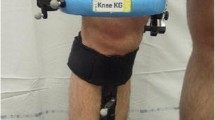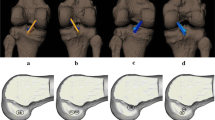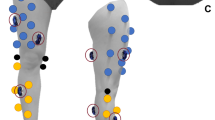Abstract
Purpose
To evaluate the effect of knee hyperextension on dynamic in vivo kinematics after anterior cruciate ligament reconstruction (ACL-R).
Methods
Forty-two patients underwent unilateral ACL-R. Twenty-four months after surgery, subjects performed level walking and downhill running on a treadmill while dynamic stereo radiographs were acquired at 100 (walking) and 150 Hz (running). Tibiofemoral motion was determined using a validated model-based tracking process, and tibiofemoral translations/rotations were calculated. The range of tibiofemoral motions from 0 to 10% of the gait cycle (heel strike to early stance phase) and side-to-side difference (SSD) were calculated. Maximum knee extension angle of ACL-reconstructed knees during walking was defined as active knee extension angle in each subject. Correlations between maximum knee extension angle and tibiofemoral kinematics data were evaluated using Spearman’s rho (P < 0.05).
Results
No significant correlation was observed between maximum knee extension angle and the range of anterior tibial translation during functional activities in the ACL-R knees. Maximum knee extension angle was weakly correlated with internal tibial rotation range in ACL-R knee during running (ρ = 0.376, P = 0.014); however, maximum extension angle was not correlated with SSD of internal tibial rotation. SSD of internal tibial rotation was −0.4° ± 1.9° (walking), −1.6° ± 3.1° (running), indicating ACL-R restored rotatory knee range of motion during functional movements.
Conclusion
Knee hyperextension was not significantly correlated with greater SSD of anterior translation and internal rotation. The clinical relevance is that knee hyperextension does not adversely affect kinematic outcomes after ACL-R and that physiologic knee hyperextension can be restored after ACL-R when knee hyperextension is present.
Level of evidence
III.




Similar content being viewed by others
Abbreviations
- ACL:
-
Anterior cruciate ligament
- SSD:
-
Side-to-side difference
- AM:
-
Anteromedial
- PL:
-
Posterolateral
- DSX:
-
Dynamic stereo X-ray
- CT:
-
Computed tomography
- PRO:
-
Patient-reported outcome
- SD:
-
Standard deviation
- MRI:
-
Magnetic resonance imaging
References
Amis AA, Dawkins GP (1991) Functional anatomy of the anterior cruciate ligament. Fibre bundle actions related to ligament replacements and injuries. J Bone Joint Surg Br 73(2):260–267
Anderst W, Zauel R, Bishop J, Demps E, Tashman S (2009) Validation of three-dimensional model-based tibio-femoral tracking during running. Med Eng Phys 31(1):10–16
Andriacchi TP, Dyrby CO (2005) Interactions between kinematics and loading during walking for the normal and ACL deficient knee. J Biomech 38(2):293–298
Araujo PH, van Eck CF, Macalena JA, Fu FH (2011) Advances in the three-portal technique for anatomical single- or double-bundle ACL reconstruction. Knee Surg Sports Traumatol Arthrosc 19(8):1239–1242
Barber SD, Noyes FR, Mangine RE, McCloskey JW, Hartman W (1990) Quantitative assessment of functional limitations in normal and anterior cruciate ligament-deficient knees. Clin Orthop Relat Res 255:204–214
Beighton P, Horan F (1969) Orthopaedic aspects of the Ehlers-Danlos syndrome. J Bone Joint Surg Br 51(3):444–453
Benner RW, Shelbourne KD, Gray T (2016) The degree of knee extension does not affect postoperative stability or subsequent graft tear rate after anterior cruciate ligament reconstruction with patellar tendon autograft. Am J Sports Med 44(4):844–849
Berchuck M, Andriacchi TP, Bach BR, Reider B (1990) Gait adaptations by patients who have a deficient anterior cruciate ligament. J Bone Joint Surg Am 72(6):871–877
Cross MJ, Wootton JR, Bokor DJ, Sorrenti SJ (1993) Acute repair of injury to the anterior cruciate ligament. A long-term followup. Am J Sports Med 21(1):128–131
De Carlo MS, Sell KE (1997) Normative data for range of motion and single leg hop in high school students. J Sport Rehabil 6:246–255
Fu FH, van Eck CF, Tashman S, Irrgang JJ, Moreland MS (2015) Anatomic anterior cruciate ligament reconstruction: a changing paradigm. Knee Surg Sports Traumatol Arthrosc 23(3):640–648
Grood ES, Suntay WJ (1983) A joint coordinate system for the clinical description of three-dimensional motions: application to the knee. J Biomech Eng 105(2):136–144
Harter RA, Osternig LR, Singer KM, James SL, Larson RL, Jones DC (1988) Long-term evaluation of knee stability and function following surgical reconstruction for anterior cruciate ligament insufficiency. Am J Sports Med 16(5):434–443
Hofbauer M, Muller B, Murawski CD, van Eck CF, Fu FH (2014) The concept of individualized anatomic anterior cruciate ligament (ACL) reconstruction. Knee Surg Sports Traumatol Arthrosc 22(5):979–986
Irrgang JJ, Enseki KR (2008) Rehabilitation following ACL reconstruction. In: Fu FH, Cohen S (eds) Current concepts in ACL reconstruction. SLACK Incorporated, Thorofare
Irrgang JJ, Tashman S, Moore C, Fu FH (2012) Challenge accepted: description of an ongoing NIH-funded randomized clinical trial to compare anatomic single-bundle versus anatomic double-bundle ACL reconstruction. Arthroscopy 28(6):745–747 (author reply 747–748)
Jagodzinski M, Richter GM, Passler HH (2000) Biomechanical analysis of knee hyperextension and of the impingement of the anterior cruciate ligament: a cinematographic MRI study with impact on tibial tunnel positioning in anterior cruciate ligament reconstruction. Knee Surg Sports Traumatol Arthrosc 8(1):11–19
Jaureguito JW, Paulos LE (1996) Why grafts fail. Clin Orthop Relat Res 325:25–41
Kim SJ, Kim TE, Lee DH, Oh KS (2008) Anterior cruciate ligament reconstruction in patients who have excessive joint laxity. J Bone Joint Surg Am 90(4):735–741
Kim SJ, Moon HK, Kim SG, Chun YM, Oh KS (2010) Does severity or specific joint laxity influence clinical outcomes of anterior cruciate ligament reconstruction? Clin Orthop Relat Res 468(4):1136–1141
Kuster M, Wood GA, Sakurai S, Blatter G (1994) 1994 Nicola Cerulli young researchers award. Downhill walking: a stressful task for the anterior cruciate ligament? A biomechanical study with clinical implications. Knee Surg Sports Traumatol Arthrosc 2(1):2–7
Matsubara H, Okazaki K, Tashiro Y, Toyoda K, Uemura M, Hashizume M, Iwamoto Y (2013) Intercondylar roof impingement after anatomic double-bundle anterior cruciate ligament reconstruction in patients with knee hyperextension. Am J Sports Med 41(12):2819–2827
Myer GD, Ford KR, Paterno MV, Nick TG, Hewett TE (2008) The effects of generalized joint laxity on risk of anterior cruciate ligament injury in young female athletes. Am J Sports Med 36(6):1073–1080
Ramesh R, Von Arx O, Azzopardi T, Schranz PJ (2005) The risk of anterior cruciate ligament rupture with generalised joint laxity. J Bone Joint Surg Br 87(6):800–803
Rubinstein RA Jr, Shelbourne KD, VanMeter CD, McCarroll JR, Rettig AC, Gloyeske RL (1995) Effect on knee stability if full hyperextension is restored immediately after autogenous bone-patellar tendon-bone anterior cruciate ligament reconstruction. Am J Sports Med 23(3):365–368
Saito K, Hatayama K, Terauchi M, Hagiwara K, Higuchi H, Takagishi K (2015) Clinical outcomes after anatomic double-bundle anterior cruciate ligament reconstruction: comparison of extreme knee hyperextension and normal to mild knee hyperextension. Arthroscopy 31(7):1310–1317
Sakane M, Fox RJ, Woo SL, Livesay GA, Li G, Fu FH (1997) In situ forces in the anterior cruciate ligament and its bundles in response to anterior tibial loads. J Orthop Res 15(2):285–293
Seto JL, Orofino AS, Morrissey MC, Medeiros JM, Mason WJ (1988) Assessment of quadriceps/hamstring strength, knee ligament stability, functional and sports activity levels five years after anterior cruciate ligament reconstruction. Am J Sports Med 16(2):170–180
Shelbourne KD, Gray T (2009) Minimum 10-year results after anterior cruciate ligament reconstruction: how the loss of normal knee motion compounds other factors related to the development of osteoarthritis after surgery. Am J Sports Med 37(3):471–480
Shelbourne KD, Urch SE, Gray T, Freeman H (2012) Loss of normal knee motion after anterior cruciate ligament reconstruction is associated with radiographic arthritic changes after surgery. Am J Sports Med 40(1):108–113
Snyder-Mackler L, Fitzgerald GK, Bartolozzi AR 3rd, Ciccotti MG (1997) The relationship between passive joint laxity and functional outcome after anterior cruciate ligament injury. Am J Sports Med 25(2):191–195
Tashman S, Araki D (2013) Effects of anterior cruciate ligament reconstruction on in vivo, dynamic knee function. Clin Sports Med 32(1):47–59
Tashman S, Collon D, Anderson K, Kolowich P, Anderst W (2004) Abnormal rotational knee motion during running after anterior cruciate ligament reconstruction. Am J Sports Med 32(4):975–983
Uhorchak JM, Scoville CR, Williams GN, Arciero RA, St Pierre P, Taylor DC (2003) Risk factors associated with noncontact injury of the anterior cruciate ligament: a prospective four-year evaluation of 859 West Point cadets. Am J Sports Med 31(6):831–842
van Eck CF, Illingworth KD, Fu FH (2010) Quadriceps tendon: the forgotten graft. Arthroscopy 26(4):441–442 (author reply 442–443)
Yagi M, Wong EK, Kanamori A, Debski RE, Fu FH, Woo SL (2002) Biomechanical analysis of an anatomic anterior cruciate ligament reconstruction. Am J Sports Med 30(5):660–666
Acknowledgements
The authors gratefully acknowledge the support with collecting data by Eric Thorhauer M.S., Yuichi Hoshino, M.D., Ph.D., Yoshimasa Fujimaki, M.D., Ph.D., Daisuke Araki, M.D., Ph.D., and Yuichiro Nishizawa, M.D., Ph.D.
Author information
Authors and Affiliations
Corresponding author
Ethics declarations
Conflict of interest
The authors declare that we have no potential conflict of interest.
Funding
This study was supported by NIH/NIAMS Grant #R01 AR056630.
Ethical approval
The institutional review board (IRB) for human subject research in University of Pittsburgh approved all aspects of this study (ID: PRO09020493).
Funding
Informed consent was obtained for all patients before enrolment.
Rights and permissions
About this article
Cite this article
Nagai, K., Gale, T., Herbst, E. et al. Knee hyperextension does not adversely affect dynamic in vivo kinematics after anterior cruciate ligament reconstruction. Knee Surg Sports Traumatol Arthrosc 26, 448–454 (2018). https://doi.org/10.1007/s00167-017-4653-0
Received:
Accepted:
Published:
Issue Date:
DOI: https://doi.org/10.1007/s00167-017-4653-0




